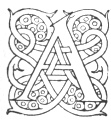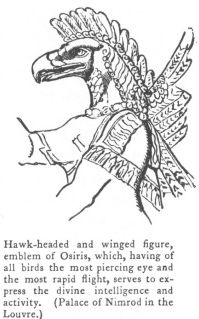
Sacred Texts Legendary Creatures Symbolism Index Previous Next
Buy this Book at Amazon.com


Fictitious and Symbolic Creatures in Art, by John Vinycomb, [1909], at sacred-texts.com
"Down hither prone in flight
He speeds, and through the vast ethereal sky
Sails between world and world with steady wings:
Now on the polar wind, then with quick fan
Winnows the buxom air."—Milton.
 |
form like to his own, and with attributes of volition and power suggested by wings. Scripture itself justifies the similitude; the Almighty is sublimely represented as "walking upon the wings of the wind." Wings have always been the symbol or attribute of
volition, of mind, or of the spirit or air. No apter emblem could be found for a rapid and resistless element than birds or the wings of birds; and however incongruous such appendages may be, and anatomically impossible, it is figuratively as the messengers of God's will to man that we have come to view these celestial habitants.
The idea of adding wings to the human form has existed from remote antiquity, and for the earliest suggestion of celestial beings of the winged human type we must look to the art works of Egypt and Assyria. In Egyptian art, Neith, the goddess of the heavens, was sometimes represented with wings, and in the marbles of Nineveh we find human figures displaying four wings. * In classic art wings are
given to certain divinities and genii. The Jews probably borrowed the idea from the Egyptians, and the early Christians adopted—in this as in many other instances—existing
 |
In holy writ and Jewish tradition angels are usually spoken of as men, and their wings appear to be implied rather than expressed, as when Abraham in the plains of Mamré addresses his celestial visitors as "my lord," when Jacob wrestles with the angel, and more particularly when the Angel at the Sepulchre is described by St. Matthew, "His countenance was like the lightning and his raiment white as snow," and by St. Mark as A young man clothed in a long white garment."
The Seraphim and Cherubim as winged beings are more perfectly described in the Scriptures.
The Wings Variously Coloured.—Not content with a simple departure in form from all natural wings, the early and Middle Age artists resorted to many
expedients to invest their angels’ wings with unearthly characteristics. Colour was a fertile field for their ingenuity, and they lavished all their brilliant hues in accentuating or separating the several orders of feathers comprising the wings; now rivalling the rainbow, now applying the startling contrasts of the most gorgeous tropical butterfly; at other times sprinkling or tipping the richly painted feathers with burnished gold, or making them appear alive with brilliant eyes.
Vesture.—In Early Christian Art the white vesture spoken of by St. Matthew and St. John, almost invariably adopted, consisted of garments resembling the classic tunica and pallium, sometimes bound with the "golden girdle" of Revelation. During the mediæval period they were clad in every brilliant colour. Angels do not often appear in the works of art executed during the first six centuries of the Church; and previous to the fifth century they were invariably represented without the nimbus—that attribute of divinity with which they were almost always invested throughout the whole range of Middle Age art.
Nimbus.—The nimbi given to all the orders of the angelic hierarchy are circular in form, with their fields either plain or covered with numerous radiating lines or rays, sometimes with broad borders of ornament, but never with the tri-radiate form, which was specially reserved for the persons of the trinity.
Lord Bacon ("Advancement of Learning," Book i.) says we find, as far as credit is to be given to the ecclesiastical hierarchy of the supposed Dionysius, the Senator of Athens, that the first place or degree is given to the angels of love, which are termed Seraphim; the second to the angels of light, which are termed Cherubim; and the third, and so following places, to thrones, principalities, and the rest, which are all angels of power and ministry, so that the angels of knowledge and illumination are placed before the angels of office and domination.
Fallen Angels.—We learn from Tradition that many angels, originally holy like the rest, fell from their pristine purity, becoming so transformed in character that all their powers are now used for the purpose of doing evil instead of doing good. These are to be identified with the devils so frequently mentioned in holy writ. By the artists of the Middle Ages they are depicted in as hideous a manner as could be conceived, more generally of the Satyr form with horns and hoofs and tail, which last connects them with the Dragon of the Apocalypse, the impersonation of the Supreme Spirit of evil (see Dragon). In Milton's conception Satan—the fallen Angel—assumes noble and magnificent proportions.
28:* See Audsley's "Glossary of Architecture," "Angel," p. 101.